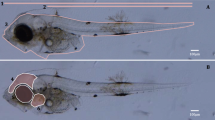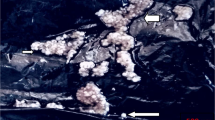Abstract
The effects of the different catching methods (gillnet, longline, harpoon) on sensory, chemical (pH, total volatile base nitrogen, K-value) and microbiological (total viable count [TVC]) changes in pike perch Sander lucioperca stored in ice were investigated. The same soaking time was used for both gillnet and longline fishing. The catching method had considerable influence on the freshness quality of pike perch. The acceptable shelf life was 15 days for pike perch caught by gillnet, and 22 days for longline and harpoon. The initial concentrations of inosine monophosphate (2.4 μmol/g) in pike perch caught by gillnet were significantly lower (P<0.05) than longline (4.1 μmol/g). and especially by harpoon (16.7 μmol/g). However, the initial K-values for fish caught by harpoon were significantly (P<0.05) lower (24.36%) than fish caught by longline and gillnet (57.69%, 64.41%, respectively). The average K, Ki, G and H-values at rejection day in terms of sensory assessment were approximately 90, 98, 156 and 40%, respectively, for all catching methods during ice storage. However, TVC reached 7.0 log cfu/g after approximately 11 days of storage for fish caught by gillnet, 19 days for fish caught by longline and 8 days for fish caught by harpoon. The result of this study suggests that the best catching method for preserving the freshness of pike perch is longline, based on the data obtained from the sensory and microbiological analysis.
Similar content being viewed by others
References
Whittle K, Hardy R, Hobbs G. Chilled fish and fishery products. In: Gormley T (ed.), Chilled Foods: The State of the Art. Elsevier, New York, 1990; 87–116.
Ashie IN, Smith JP, Simpson BK. Spoilage and shelf-life extension of fresh fish and shellfish. Crit. Rev. Food Sci. 1996; 36: 87–121.
Love R. Biochemical dynamics and the quality of fresh and frozen fish. In: Hall G (ed.), Fish Processing Technology. Blackie, London, 1997; 1–31.
Özogul Y, Özogul F. Effects of slaughtering methods on sensory, chemical and microbiological quality of rainbow trout (Onchorynchus mykiss) stored in ice and MAP. Eur. Food Res. Technol. 2004; 219: 211–216.
Hattula T, Luoma T, Kostiainen R, Poutanen J, Kallio M, Suuronen P. Effects of catching method on different quality parameters of Baltic herring (Clupea harengus). Fish. Res. 1995; 23: 209–221.
Hattula T. Adenosine triphosphate breakdown products as a freshness indicator of some fish species and fish products. Espoo 1997, Technical Research Centre of Finland. VIT Publications. 1997; 297, 48p. +app. 31p.
Botta JR, Bonnell G, Squires BE. Effect of method of catching and time of season on sensory quality of fresh raw Atlantic cod (Gadus morhua). J. Food Sci. 1987; 52: 928–931.
Esaiassen M, Nilsen H, Joensen S, Skjerdal T, Carlehög M, Eilertsen G, Gundersen B, Elvevoll E. Effects of catching methods on quality changes during storage of cod (Gadus morhua). Food Sci. Technol./LWT 2004; 37: 643–648.
Cole RG, Alcock NK, Handley SJ, Grange KR, Black S, Cairney D, Day J, Ford S, Jerrett AR. Selective capture of blue cod (Parapercis colias) by potting: behavioural observations and effects of capture method on peri-mortem fatigue. Fish. Res. 2003; 60: 381–392.
Branch AC, Vail AMA. Bringing fish inspection into the computer age. Food Technol. Aust. 1985; 37: 352–355.
Paulus K, Zacharias R, Robinson L, Geidel H. Kritische betrachtungen zur ‘bewertenden prüfung mit skale’ als einem wesentlichen verfahren der sensorischen analyse. Lebens. Wiss. U. Technol. 1979; 12: 52–61.
Association of Official Analytical Chemists. Official Methods of Analysis of the Association of the Official Analysis Chemists, 14th edn. AOAC, Washington DC. 1984.
Bligh EG, Dyer WJ. A rapid method of total lipid extraction and purification. Can. J. Biochem. Physiol. 1959; 37: 911–917.
Lima dos Santos C, James D, Teutscher F. Guidelines for chilled fish storage experiments. FAO Fish Tech. Paper, Food and Agricultural Organization. Rome, 1981; 210.
Antonocopoulus N. Bestmmung des Flüchhtigen Basensticktoofs. In: Ludorf W, Meyer V (eds). Fische und Fischerzeugnisse. Aulage Verlag Paul Parey, Berlin. 1973; 224–225.
Özogul F, Taylor KDA, Quantick P, Özogul Y. Chemical, microbiological and sensory evaluation of Atlantic herring (Clupea harengus) stored in ice, modified atmosphere and vacuum pack. Food Chem. 2000; 71: 267–273.
Saito T, Arai K, Matsuyoshi M. A new method for estimating the freshness of fish. Bull. Jpn Soc. Sci. Fish. 1959; 24: 749–750.
Karube I, Matsuoka H, Suzuki S, Watanabe E, Toyama T. Determination of fish freshness with an enzyme sensor system. J. Agr. Food Chem. 1984; 32: 314–319.
Burns GB, Ke PJ, Irvine BB. Objective procedure for fish freshness evaluation based on nucleotide changes using a HPLC system. Fisheries and Oceans, Scotia-Fund Region, Nova Scotia. Can. Tech. Rep. Fish. Aquat. Sci. 1985; 1373: 35.
Luong JHT, Male KB, Masson C, Nguyen AL. Hypoxanthine ratio determination in fish extract using capillary electrophoresis and immobilized enzymes. J. Food Sci. 1992; 54: 77–81.
Acuff G, Izat AL, Finne G. Microbial flora of pond-reared tilapia (Tilapia aurea) held on ice. J. Food Prot. 1984; 47: 778–780.
González CJ, Lòpez TM, García ML, Prieto M, Otero A. Bacterial microflora of wild brown trout (Salmo trutta), wild pike (Esox lucius), and aquacultured rainbow trout (Oncorhynchus mykiss). J. Food Prot. 1999; 62: 1270–1277.
Gelman A, Glatman L, Drabkin V, Harpaz S. Effects of storage temperature and preservative treatment on shelf life of the pond-raised freshwater fish, silver perch (Bidyanus bidyanus). J. Food Prot. 2001; 64: 1584–1591.
Savvaidis IN, Skandamis PN, Riganakos KA, Panagiotakis N, Kontaminas MG. Control of natural microbial flora and Listeria monocytogenes in vacuum-packaged trout at 4 and 10°C using irradiation. J. Food Prot. 2002; 65: 515–522.
International Commission on Microbiological Specifications for Foods (ICMSF). Sampling plans for fish and shellfish, in microorganisms in foods. Sampling for Microbiological Analysis; Principles and Scientific Applications. ICMSF. Vol. 2, 2nd edn. University of Toronto Press, Toronto, Canada. 1986; 181–196.
Olgunoglu IA, Polat A, Var I. Chemical and sensory changes of pike perch (Sander lucioperca) fillets during frozen storage (−18°C). Turk. J. Vet. Anim. Sci. 2002; 26: 879–884.
Jankowska B, Zakes Z, Zmijewski T, Szczepkowski M. A comparison of selected quality features of the tissue and slaughter yield of wild and cultivated pikeperch Sander lucioperca (L.). Eur. Food Res. Technol. 2003; 217: 401–405.
Çelik M, Diler A, Küçükgülmez A. A comparison of the proximate compositions and fatty acid profiles of zander (Sander lucioperca) from two different regions and climatic conditions. Food Chem. 2005; 92: 637–641.
Bjordal A, Løkkeborg S: Longlining Fishing. New Books, Oxford. 1996.
Özogul Y, Özyurt G, Özogul F, Kuley E, Polat A. Freshness assessment of European eel (Anguilla anguilla) by sensory, chemical and microbiological methods. Food Chem. 2005: 92: 745–751.
Tomlinson N, Arnold ES, Roberts E, Geiger SE. Observation on post mortem biochemical changes in fish muscle in relation to Rigor mortis. J. Fish. Res. Board Can. 1961; 18: 321–336.
Kietzmann U, Priebe K, Rakov D, Rekhstein K. Seefisch als Lebensmittel. Paul Parey Verlag, Berlin. 1969.
Ludorf W, Meyer V. Fische und Fischerzeugnisse. Paul Parey Verlag, Berlin. 1973.
Lang K. Der flüchtige Basenstickstoff (TVB-N) bei im Binnenland in der Verkehr gebrachten frischen Seefischen. II. Mitteilung. Arc. Lebensm. Hyg. 1983; 34: 7–9.
Tejada M, Huidobro A. Quality of farmed gilthead sea bream (Sparus aurata) during ice storage related to the slaughter method and gutting. Eur. Food Res. Technol. 2002; 215: 1–7.
Kyrana VR, Lugovois VP, Valsamis DS. Assessment of shelf-life of maricultured gilthead sea bream (Sparus aurata) stored in ice. Int. J. Food Sci. Technol. 1997; 32: 339–347.
Chytiri S, Chouliara I, Savvaidis IN, Kontominas MG. Microbiological, chemical and sensory assessment of iced whole and filleted aquacultured rainbow trout. Food Microbiol. 2004; 21: 157–165.
Huidobro A, Mendes R, Nunes ML. Slaughtering of gilthead seabream (Sparus aurata) in liquid ice: influence on fish quality. Eur. Food Res. Technol. 2001; 213: 267–272.
Grigorakis K, Taylor KDA, Alexis MN. Seasonal patterns of spoilage of ice-stored cultured gilthead sea bream (Sparus aurata). Food Chem. 2003; 81: 263–268.
Özogul F, Gökbulut C, Özyurt G, Özogul Y, Dural M. Quality assessment of gutted wild sea bass (Dicentrarchus labrax) stored in ice, cling film and aluminium foil. Eur. Food Res. Technol. 2005; 220: 292–298.
Murata M, Sakaguchi M. The effects of phosphatase treatment of yellowtail muscle extracts and subsequent addition of IMP on flavor intensity. Nippon Suisan Gakkaishi 1989; 55: 1599–1603.
Jacober LF, Rand JAG. Biochemical evaluation of seafood. In: Martin RE, Flick GJ, Herbard CE, Ward DR (eds) Chemistry and Biochemistry of Marine Food Products. Avi Publishing Co., Westport, CT. 1982: 347–366.
Özogul Y, Özoĝul F, Gökbulut C. Quality assessment of wild European eel (Anguilla anguilla) stored in ice. Food Chem. 2006; 95: 458–465.
Va’zquez-Ortiz FA, Pacheco-Aguilar R, Lugo-Sanchez ME, Villegas-Ozuna RE. Application of the freshness quality index (K Value) for fresh fish to canned sardines from Northwestern Mexico. J. Food Comp. Anal. 1997; 10: 158–165.
Lougovois VP, Kyranas ER, Kyrana VR. Comparison of selected methods of assessing freshness quality and remaining storage life of iced gilthead sea bream (Sparus aurata). Food Res. Int. 2003; 36: 551–560.
Author information
Authors and Affiliations
Corresponding author
Rights and permissions
About this article
Cite this article
Özyurt, G., Özogul, Y., Özyurt, C.E. et al. Determination of the quality parameters of pike perch Sander lucioperca caught by gillnet, longline and harpoon in Turkey. Fish Sci 73, 412–420 (2007). https://doi.org/10.1111/j.1444-2906.2007.01349.x
Received:
Accepted:
Issue Date:
DOI: https://doi.org/10.1111/j.1444-2906.2007.01349.x




